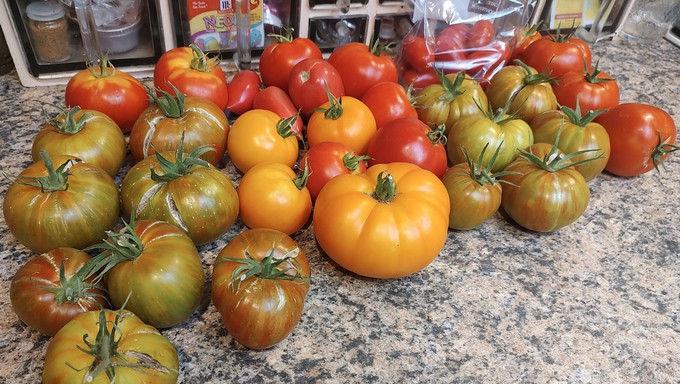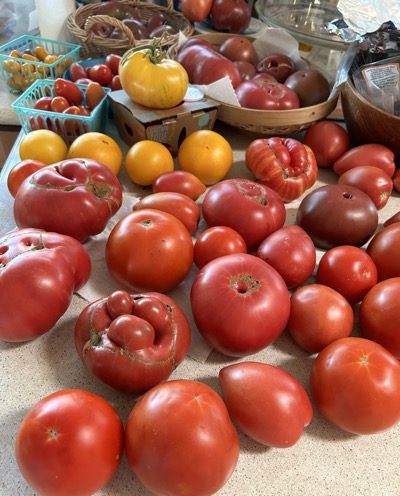
2023 was a great tomato year for gardeners, farmers who planted later

Good year for Debbie, too: One day's harvest including Berkeley Tie Dye, Chef's Choice Orange and First Prize tomatoes. Juliet tomatoes are in the bag. Debbie Arrington
Was this a good tomato year? For many Sacramento-area gardeners, the answer was a resounding YES!
That’s the consensus of our readers when we asked them to evaluate their Crop of ’23.
“AMAZING!” wrote R. Buckeye Carter. “I think it was because of a cool June. Cooler nights this year, too. Also picked better varieties specific to the region.”
“I have an amazing crop this year!” echoed Christina Borgman. “It's been five years since I got anything more than a couple of small-sized ‘Big Beef’ tomatoes.”
Of course, not everyone had such tomato luck. Reader Robin Wham said, “My tomato crop is the worst ever this year. Are others having this challenge? Was it the long spring?”
Robin’s experience and questions are what spurred our follow-up to Sacramento Digs Gardening readers: Bummer or bumper?
The most common description: Bumper! That was especially welcome after several challenging summers.
“I’ve had a bumper crop and about time, too,” wrote Michelle Jackson of Elk Grove. “Last year was lousy, so I’m enjoying what I have this year: Ace Champion 2, Crimson Carmello, and Gardeners Delight.”
“Bumper for us here in Citrus Heights,” added Tina Ruse. “Bumper,” repeated Deborah Catherwood.
Cathy Hollister had a mixed summer: "Mine did okay this year. I had a decent crop but have had to deal with fungus. I got one that caused a black fungus at the stem and my almost-ripe to ripe tomatoes would just drop whole. They would have black fungus at the stem and be rotten inside. Ive never had this before. I lost about 20 or so tomatoes. I still have a good enough crop. I planted a lot and have been the tomato fairy in my neighborhood."
Ellen Tresidder of Roseville found frustration with heirlooms. "In late May I purchased and planted four tomato plants from Green Acres, all in a row in my raised bed (soil amended with organic compost and coconut coir mixture)," she wrote. "Three were indeterminate heirloom varieties from Wild Boar Farms and one Roma. After getting off to a good start and setting fruit, two of the three heirloom varieties just started to wilt. Then, one plant completely died, and then a month later the second one as well. The third heirloom had tomatoes on the vine and kept growing, but no more tomatoes formed, but that Roma just thrived in the heat wave and kept going."
Martin Miller had somewhat better success, especially with a certain dark heirloom. "Perhaps my best crops of Black Krim ever!" he wrote. "Amazing quantity of larger than typical fruit off of four plants. Berkeley Tie Dye did very good along with Black Cherry, Juliet, Enchantment and Chocolate Sprinkles. Sungold started great and faded fast. The Zebras, Costuluto, and a few other experiments were a failure. Other than Shishitos, peppers were average this year."
"Count me as one of the gardens with a bumper crop of tomatoes," reported Linda Pittman of Wilton. "Normally, I plant as early as mid-March (knowing we’ll have frost a couple of days before spring seriously settles in), but I was on vacation for two weeks in April. As a result, I didn’t plant my garden until the first week of May. ... I got my first ripe tomatoes the end of the first week of July. From mid-July on, I’ve been eating tomatoes almost every day and, of course, sharing with friends. At the end of July, I harvested 60 or more pounds of tomatoes in one day."
As with all crops, timing is everything. Gardeners who transplanted their tomato seedlings outdoors too soon – March and early April – had the least success. The weather and ground were too cold.
But those who waited until mid- to late April or even May benefited from that cooler late spring weather. The vines were able to develop and mature before facing the challenges of triple-digit heat.
Other crops – mainly squash – tended to sulk in that cooler weather and not produce as much as expected.
“This summer is one of the best ever for tomatoes and peppers, so-so for zucchini,” said popular podcaster and lifetime master gardener Farmer Fred Hoffman, who gardens in Folsom. “I’m not complaining, mind you!”

That wet, cool early spring delayed planting for many commercial tomato growers. That got California’s tomato crop off to a late start. But expect to see tomato trucks rolling on state highways well into October.
The USDA released its 2023 California Processing Tomato Report on Aug. 30, updating its spring estimates. The state’s 2023 crop of processing (or canning) tomatoes is now expected to be 12.9 million tons, 23% more than 2022’s contracted crop. Part of that increase: More acres were planted in 2023 – 254,000 acres, up 13%.
“Unseasonably wet weather through winter and spring delayed planting by weeks, but with record-high prices and ample water, contracted acreage increased significantly,” explained the USDA report. “Harvest began with a slow start in mid-July, a couple weeks behind average, and is expected to continue well through October if the weather stays dry. Now entering peak harvest, canneries are busy managing the logistics of consistently delivering ripe tomatoes to the plant.”
In late August, tomato shipments to canneries were tracking a little behind 2022, the report noted. “However, due to the late crop, shipments are expected to catch up and exceed the past five years.”
So, even if your own tomato crop started out sluggish, there’s still hope of more tomatoes to come.
Comments
0 comments have been posted.Sacramento Digs Gardening to your inbox.
Food in My Back Yard Series
May 6: Maintain soil moisture with mulch for garden success
April 29: What's (already) wrong with my tomato plants?
April 22: Should you stock up on fertilizer? (Yes!)
April 15: Grow culinary herbs in containers
April 8: When to plant summer vegetables
April 1: Don't be fooled by these garden myths
March 25: Fertilizer tips: How to 'feed' your vegetables for healthy growth
March 18: Time to give vegetable seedlings some more space
March 11: Ways to win the fight against weeds
March 4: Potatoes from the garden
Feb. 25: Plant a fruit tree now -- for later
Feb. 18: How to squeeze more food into less space
Feb. 11: When to plant? Consider staggering your transplants
Feb. 4: Starting in seed starting
Sites We Like
Garden Checklist for week of May 11
Make the most of the lower temperatures early in the week. We’ll be back in the 80s by Thursday.
* Plant, plant, plant! It’s prime planting season in the Sacramento area. Time to set out those tomato transplants along with peppers and eggplants. Pinch off any flowers on new transplants to make them concentrate on establishing roots instead of setting premature fruit.
* Direct-seed melons, cucumbers, summer squash, corn, radishes, pumpkins and annual herbs such as basil.
* Harvest cabbage, lettuce, peas and green onions.
* In the flower garden, direct-seed sunflowers, cosmos, salvia, zinnias, marigolds, celosia and asters. (You also can transplant seedlings for many of the same flowers.)
* Plant dahlia tubers.
* Transplant petunias, marigolds and perennial flowers such as astilbe, columbine, coneflowers, coreopsis, dahlias, rudbeckia and verbena.
* Keep an eye out for slugs, snails, earwigs and aphids that want to dine on tender new growth.
* Feed summer bloomers with a balanced fertilizer.
* For continued bloom, cut off spent flowers on roses as well as other flowering plants.
* Add mulch to the garden to maintain moisture. Mulch also cuts down on weeds. But don’t let it mound around the stems or trunks of trees or shrubs. Leave about a 6-inch-to-1-foot circle to avoid crown rot or other problems.
* Remember to weed! Pull those nasties before they set seed.
* Water early in the day and keep seedlings evenly moist.